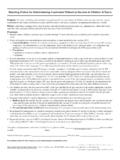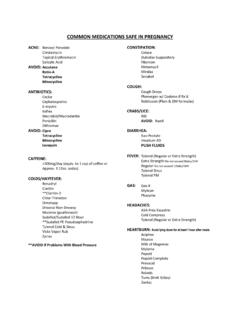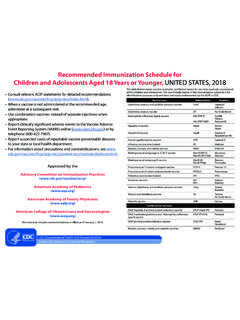Transcription of Transgenic mice as an alternative to monkeys for ...
1 Transgenic mice as an alternative to monkeys forneurovirulence testing of live oral poliovirus vaccine:validation by a WHO collaborative studyEugenia Dragunsky,1 Tatsuji Nomura,2 Kazimir Karpinski,3 John Furesz,4 David J. Wood,5 Yuri Pervikov,6 Shinobu Abe,7 Takeshi Kurata,8 Olivier Vanloocke,9 Galina Karganova,10 Rolf Taffs,11 Alan Heath,12 Anna Ivshina,13& Inessa Levenbook14 ObjectiveExtensive WHO collaborative studies were performed to evaluate the suitability of Transgenic mice susceptible to poliovirus (TgPVR mice, strain 21, bred and provided by the Central Institute for Experimental Animals, Japan) as an alternative to monkeys in theneurovirulence test (NVT) of oral poliovirus vaccine (OPV).
2 MethodsNine laboratories participated in the collaborative study on testing neurovirulence of 94 preparations of OPV and vaccinederivatives of all three serotypes in TgPVR21 analysis of the data demonstrated that the TgPVR21 mouse NVT was of comparable sensitivity and reproducibilityto the conventional WHO NVT in simians. A statistical model for acceptance/rejection of OPV lots in the mouse test was developed,validated, and shown to be suitable for all three vaccine types. The assessment of the Transgenic mouse NVT is based on clinicalevaluation of paralysed mice.
3 Unlike the monkey NVT, histological examination of central nervous system tissue of each mouse offeredno advantage over careful and detailed clinical on data from the collaborative studies the WHO Expert Committee for Biological Standardization approved themouse NVT as an alternative to the monkey test for all three OPV types and defined a standard implementation process for laboratoriesthat wish to use the test. This represents the first successful introduction of Transgenic animals into control of vaccine, Oral/toxicity; Mice, Transgenic /physiology; Macaca mulatta; Nervous system/virology; Virulence; Sensitivityand specificity; Reproducibility of results; World Health Organization; Comparative study; Validation studies (source: MeSH, NLM).
4 Mots cle sVaccin antipoliomye litique Sabin/toxicite ; Souris transge niques/physiologie; Macaca mulatta; Syste` me nerveux/virologie;Virulence; Sensibilite et spe cificite (Epide miologie); Reproductibilite des re sultats; Organisation mondiale de la Sante ; Etudecomparative; Etude validation (source: MeSH, INSERM).Palabras claveVacuna antipolio oral/toxicidad; Ratones transge nicos/fisiolog a; Macaca mulatta; Sistema nervioso/virolog a;Virulencia; Sensibilidad y especificidad; Reproducibilidad de resultados; Organizacio n Mundial de la Salud; Estudio comparativo;Estudios de validacio n (fuente: DeCS, BIREME).
5 Bulletin of the World Health Organization 2003;81 page 259 le re sume en franc ais. En la pa gina 259 figura un resumen en espan neurovirulence test (NVT) for oral poliovirus vaccine(OPV) is a key test for monitoring the consistency of vaccineproduction (1), and following WHO guidelines is required foreach monovalent bulk lot of OPV produced. The WHO NVT(2) is a standardized procedure. If consecutive lots ofmonovalent bulks consistently meet the specifications of the1 Biologist, Center for Biologics Evaluation and Research, Food and Drug Administration, 1401 Rockville Pike, Rockville, MD 20852-1448, USA(email: Correspondence should be addressed to this , Central Institute for Experimental Animals, Miyamae, Kawasaki, Consultant, Orleans, Ontario, , Ottawa, Ontario, : Principal Scientist, National Institute for Biological Standards and Control, Potters Bar, Hertfordshire, England.)
6 Currently: Scientist, Vaccines and Biologicals,World Health Organization, Geneva, Officer, Vaccines and Biologicals, World Health Organization, Geneva, Director, Japanese Poliomyelitis Research Institute, Tokyo, Director-General, National Institute of Infectious Diseases, Tokyo, , In Vivo QC, GlaxoSmithKline Biologicals, Rixensart, Chief, Institute of Poliomyelitis and Viral Encephalitides, Moscow Region, Russian , Center for Biologics Evaluation and Research, Food and Drug Administration, Rockville, MD.
7 National Institute for Biological Standards and Control, Potters Bar, Hertfordshire, Fellow, Center for Biologics Evaluation and Research, Food and Drug Administration, Rockville, MD, Advisor, Northbrook, IL, of the World Health Organization 2003, 81 (4)WHO test, there is a high level of assurance that the vaccineswill be safe when used for human immunizations (3, 4). So far,the test for neurovirulence safety of OPV has been performedusing monkeys , because only primates are naturally susceptibleto poliovirus .
8 In 1990 91, two laboratories (5, 6) with thesupport of WHO, established lines of Transgenic mice carryinga human receptor to poliovirus . In 1992, WHO recommendedthat a comparison be made of the sensitivity of TgPVR mice(7) with that of monkeys for type-3 poliovirus strains withdifferent degrees of neurovirulence , and an evaluation ofTgPVR mice as a possible alternative to monkeys for theneurovirulence testing of OPV (8). Initial experiments wereperformed in Japan and the USA that were aimed at selectingthe most suitable TgPVR mouse line and route of inoculation,developing basic test methodology, and accumulating initialdata.
9 The results obtained with TgPVR21 mice (9, 10)indicated the capacity of the test to discriminate betweenacceptable batches of OPV and preparations of highneurovirulence. A collaborative study was therefore launchedby WHO in 1993 (11) to investigate in more detail thesuitability of the method for batch release of bulk at the Central Institute for Experimental Animals(CIEA, Japan) succeeded in developing TgPVR21 mice from alimited research tool into a reliable supply of standard animalsavailable in large numbers (12, 13).
10 Eleven institutions fromAsia, Europe, and the USA participated in the study started with type-3 OPV, the least stable strainin terms of its neurovirulence , and was completed for all threeserotypes in October 2000. The results of the collaborative studyup to 1999 have recently been published (14). The present paperpresents the final results of the collaborative study and validationof the mouse NVT. A statistical model was developed foracceptance or rejection of OPV batches in the mouse test. It haspreviously been shown that the WHO monkey NVT was areproducible and sensitive assay, ensuring the safety of OPV (3,4).















